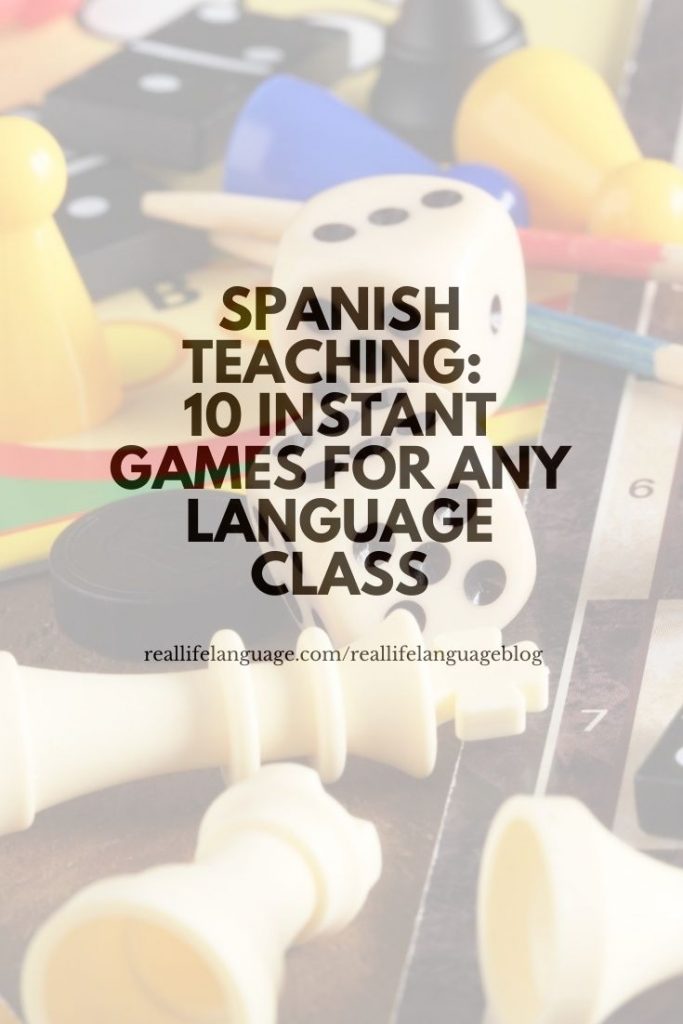After teaching Spanish for many years, I have come to believe that games are a fabulous way to learn new material. Games should not be saved for special days, but rather integrated regularly into language classes. As we know, learners need repeated contact with the target language and culture to ultimately become proficient in the language they are studying. Games are a great way to cut the monotony, add variation and movement, as well as provide many contexts within which to communicate in the target language in our classes.
These games can all be implemented in any language and in any level class. They are not just for teaching Spanish. They are designed to be little or no prep. I have used these many times over the years. I find that many of them can be used to help plan lessons, but can also be a great way to improvise when you find yourself with some unexpected time or when the class could use an infusion of energy.
Charades: This game is great, and especially so for verbs. It is one of my favorite activities for teaching Spanish. Students act out vocabulary and the rest of the class guesses the word or phrase. I find this especially helpful after introducing a new chapter’s vocabulary. The students then write the word they acted out after it is guessed on the board. You can play this in many configurations as well. It works in small groups, teams or pairs. Do this in whatever configuration works for your class. Smaller groups benefit from the opportunity for more individual speaking time. Larger groups or pairs are good for more timid students, I find.
Pictionary: Students draw target vocabulary words while the class guesses. I usually set up the rules (i.e. time, etc.) based on what will work best with each group as opposed to strict traditional rules. I also find that this is fun if you have small boards and can divide your class into small groups.
Reverse Pictionary: This is fun with small boards, paper or large boards if you have room for your class. You say the target vocabulary word. They draw it and hold it up for you to see.
CharPictionary: I am told that this is like Cranium though I have not ever played the game myself. Students are told that they can basically take any prop, create any gesture or draw any picture that they need in convey their intended vocabulary word’s meaning. A great activity for active Spanish (or any language) teaching!
Hangman: This is also fun at the beginning of a unit. After introducing vocabulary, students will likely need to refer to the new words to guess what the goal word is. However, I never use a hangman. We brainstorm target culture items or words before we begin and draw those instead. This activity provides students with reading and speaking practice.
Tic Tac Toe: I created reusable boards out of laminated construction paper and poster board of target culture flags, but paper or white boards work well as well. Divide students into small groups. I think that four is ideal for small groups, but you can divide the class into two teams and play as a group. Each team gets an X or O, or the equivalent of such. I like to use items I find in the class to help review vocabulary.
The students (or you) should ask each other the target word. They can use any of the methods mentioned above (i.e. draw, act out, etc.) but I also like to use something very simple like How do you say ___?. When a team gets a correct answer, they can put down their X or O. For teaching Spanish, I like to make a board with squares that look like Spanish-speaking country flags.
Scattegories: I like to do this in any level, but I think that the higher the level the more effective and fun this game can be.
We almost always do this in groups. Give students a topic and a time limit. They brainstorm and write as many words on that topic in the target language as they can. We then review after each round, keeping score.
Pass It: Like Flyswatter, use any representation you might have of the target vocabulary. You play target culture music and they pass the words. When you stop the music, they say the words they have.
Flyswatter: This is an old standby. You can any use items from your classroom, a transparency or drawings made by students that represent the target vocabulary. Put them on the ground. The students swat the words you say.
Hot Seat: This works for any topic and any level. The students break out into groups. They write questions on a topic you give them. They take turns in the hot seat asking and answering questions.
[leadpages_leadbox leadbox_id=1442175c6639c5] [/leadpages_leadbox]
Want to increase your time and make learning fun? Check out my course with loads of resources:
